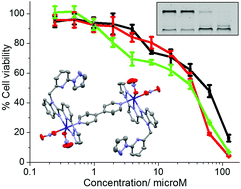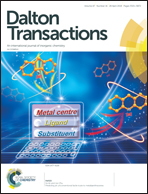Synthesis, characterization, and cytotoxic properties of mono- and di-nuclear cobalt(ii)-polypyridyl complexes†‡
Abstract
We report the synthesis and characterisation of mono- and di-nuclear cobalt(II) complexes (1–3) containing L1, a polypyridyl ligand with pyrazole moieties. DNA binding studies suggest that the mono-nuclear complex, 1, binds to DNA via the grooves prior to inducing oxidative DNA cleavage whereas the larger di-nuclear complexes, 2 and 3, bind to DNA via the grooves and through intercalation prior to inducing oxidative DNA cleavage. The cobalt(II) complexes display micromolar potency towards U2OS (bone osteosarcoma), HepG2 (liver hepatocellular carcinoma), and GM05757 (normal human fibroblast) cells, comparable to clinically used platinum agents, cisplatin and carboplatin. The cellular mechanism of action studies show that the most effective cobalt(II) complex, 2, enters U2OS cells, penetrates the nucleus, induces genomic DNA damage, and triggers caspase-dependent apoptosis in a p53-independent manner. This study highlights the potential of di-nuclear cobalt(II) complexes as artificial oxidative metallonucleases and tangible cancer cell-potent agents.



 Please wait while we load your content...
Please wait while we load your content...